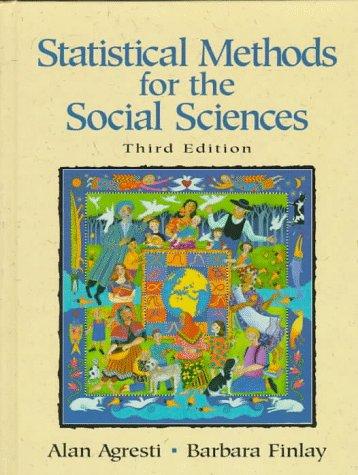43. Shortly before a gubernatorial election, a random sample of 50 potential voters are asked the following
Question:
43. Shortly before a gubernatorial election, a random sample of 50 potential voters are asked the following questions Do you consider yourself to be a Democrat (D), a Republican (R), or Independent (I)? If you were to vote today, would you vote for the Democratic candidate (D), the Republican (R). or would you be undecided (U) about how to vote? Do you plan on voting in the election? Yes (Y) or no (N)?
TABLE 8.40 Most Important Issue Ethnic Gang Violence Child Health Group Education Drugs and Crime Abuse AIDS Care Other White 440 130 180 80 80 Hispanic 660 540 420 140 140 Black 410 210 200 30 90 Asian 460 40 250 30 80 588 60 30 60 40 30 30 10 60 Source U.S. Department of Justice. Sourcebook of Criminal Justice Statistics. 1994 (Washington, DC US Government Printing Office). p. 141 TABLE 8.41 (D. U. N) (R. R. Y) (I, D, Y) (I. U, N) (R, U. N) (1. D. N) (R. R, Y) (I, U, N) (D. U. Y) (D, R, N) (1. D. N (D. D. Y) (D.D.Y) (I, D. Y) (R, U.N) (D, R. N) (R, D. N) (D. U.N) (D, D. Y) (R, R. Y) (R, R, Y) (D, D, N) (D, D, Y) (I, D, Y) (R, R. N) (D. D. Y) (D, R, Y) (J. U. N) (D.D, N) (D, D, Y) (R, R, Y) (R. R. Y) (D. U.N) (1. R, N) (1, R, Y) (R, R. Y) (IU, Y) (D, D. Y) (D.R. Y) (D,D,N) (D, D. Y) (R. Y) (R.R. Y) (LD, Y) (R, R, N) (R. R. Y (D, D, Y) (I. D, Y) (J. R, N) (R, R, Y) For each person interviewed, the answers to the three questions are entered in a data file. For example, the entry (D. U, N) represents a registered Democrat who is undecided and who does not expect to votc Table 8.41 summarizes results of the 50 interviews. Using computer software, create a data file and conduct the following analyses:
a) Construct the 3x3 conungency table relating political party affiliation to intended vote (the first two variables listed). Report the conditional distributions on intended vote for each of the three pobucal party affiliations. Are they very different?
b) Report the result of the test of the hypothesis that intended vote is independent of po- litical party affiliation: provide the test statistic, the P-value, and interpret the result.
c) Construct the 2 x 3 contingency table relating expectation of voting to political party affiliation (the first and third variables listed). Report the conditional distributions on ex- pectation of voting for each of the political party affiliations, and interpret. Test the null hypothesis of independence. and interpret.
Step by Step Answer:

Statistical Methods For The Social Sciences
ISBN: 9780135265260
3rd Edition
Authors: Alan Agresti, Barbara Finlay





